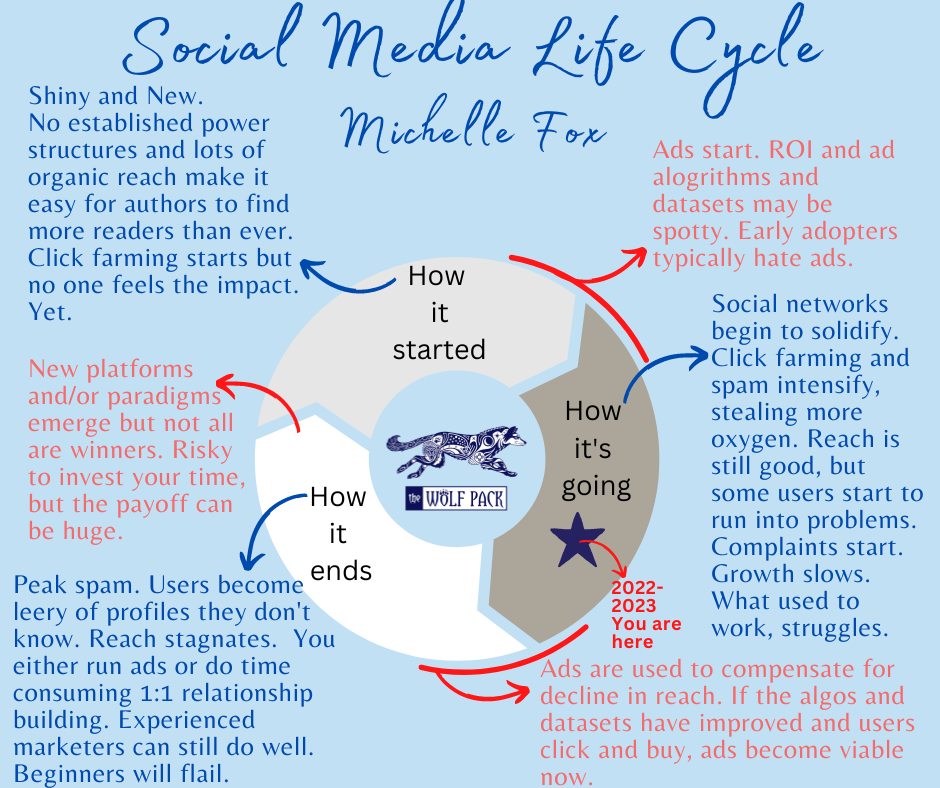We made it through 2022! A round of applause and therapeutic chocolate for everyone. Now it’s time to look forward to 2023, and I’ve put together a list of resolutions based on trends I suspect will drive book marketing throughout the new year. Where does this list come from? My own extensive research and experience running a small marketing think tank. I’ve been tracking data and trialing different ideas all year and this is what that work has revealed.
1. Peak click farms
The organic reach on TikTok and Instagram Reels that many authors have relied on is about to hit an iceberg known as click farming. Never heard of click farming? It’s the practice of gaming engagement to grab traffic on social media. It started on TikTok in 2020 and Instagram is gearing up for a new wave of click farm activity in 2023 as well.
How does it impact authors? Click farming relies on bots or dozens of fake accounts to generate fake engagement in order to trick the algorithm into prioritizing a piece of content. This ensures their content gets the lion’s share of traffic. Where most of us have been dancing and lip syncing to promote our books via video, spammers have been sucking up traffic with automation and this will reach a tipping point specifically for books in 2023.
The recent decline in reach on TikTok is symptomatic of the spam peak. There are so many click farms targeting book traffic now, there’s not enough engagement left for your books.
While click farming is penalized throughout social media, no app has been able to eradicate it completely. There’s not going to be a simple solution.
The upshot? The days of posting a few videos and selling hundreds of books are on their way out. Now it’s going to be work and a lot of hustle. Authors can still go viral, but it’ll be less and less often and it’s going to take more and more strategy.
Resolution: Build beyond organic reach. Make sure you’re funneling your readers into social media accounts to increase your engagement on those platforms so that your content is more competitive in the algorithm. At the same time, be sure to direct people to your newsletter as well to deepen your relationship with readers and create additional touchpoints for marketing. Also network with readers who are active on the platform and build your following through 1:1 outreach.
Want to learn more about the impact of click farms on social media? Here’s a good overview.
2. Book blog tours and street teams are back, baby
As the volume of work and know-how involved in marketing online increases, many authors will find they either need assistants, PR firms, or a base of active, engaged readers to promote their books. For 2023, marketing comes full circle and book tours, PR firms, and street teams are relevant again. Only this time, they’re using TikTok and Instagram instead of blogs, and readers often want to be paid.
Resolution: Make a list of different PR firms and track their various campaigns to determine how you want to interface with the resurgence of book tours. In addition, identify social media-savvy readers in your network who may be a good fit for a dedicated street team.
3. Ads meet demographics
Ads still work, but next year they’ll start working in different places. Authors will have the opportunity to move beyond Facebook, BookBub, and AMS ads. There’s a lot of testing going on behind the scenes, and early results signal authors will find more venues that can generate book sales. However, you have to know who your readers are and where they hang out online.
Demographics are going to play a much bigger role than they did previously. There are enough social media outlets now that users are siloed by age. Meaning, authors need to consider whether core users on a platform are their reader demographic before running ads.
Resolution: Research the demographics of the social media platforms you rely on and compare it to your reader demographics. You may be surprised by what you discover. This simple exercise is changing what platforms I focus on in 2023.
(And note that TikTok ads for books are still wonky—keep an eye on their ads platform. It’s still not converting very well just yet, in part due to demographics and in part to their user datasets.)

4. Video, video, video
If you haven’t made a video yet, you will in 2023. Despite most authors’ aversion and the U.S. government’s efforts to ban TikTok, video book marketing isn’t going away. Video is everywhere now and the demand will not drop even if TikTok disappears. We are in the music video era of book marketing, and what little organic reach authors have on social media resides in TikTok videos and Reels on Instagram. Time to make like Micheal Jackson and do the moonwalk.
The good news is that we are “post face.” Authors can opt out of being on screen now as readers will engage with book trailer content, which is much easier to produce and distribute. The bad news, making a book trailer that readers engage with is trickier than you’d think.
On Facebook, we had a paragraph or even a long snippet to market with, but with book trailers we have essentially movie loglines to work with, which means every word has to land. Being able to market your book in the equivalent of two or three loglines across a short video is key.
Resolution: Develop your book trailers and post them on TikTok and Instagram. If you’ve never made a book trailer, the app I’d suggest you start with is Canva as it’s easy to use, very affordable, and has robust features.

5. The rise of AI audiobooks
AI audiobook narration is already excellent and will only get better. In 2022, some authors had strong negative reactions to the idea of AI audiobook narration; however, it’s important to keep in mind that there are two major market segments for audiobooks: the one that can afford the high price of audiobooks and the one that can’t.
The budget market segment has been underserved and limping along with having Alexa or other apps read ebooks to them. Compared to that, any level of AI narration is heaven. (Also, neurodivergent listeners often prefer AI narrators.)
Use your AI narrated audiobooks to offer price points for the listener on a budget. Not serving both market segments is costing authors.
Further, there’s a lot of pressure on retailers to distribute AI narrated audiobooks, and they are signaling that it’s likely to happen. Expect to see live narrated audiobooks competing with AI narration and the best marketer will win.
Resolution: If you haven’t yet experimented with Google Play’s AI narration, take it for a test drive in 2023. Or take a look at DeepZen, which also offers copy editing and other support at a fraction of the cost of a live narrated audiobook. At least understand the technology.
Here’s a good introduction to AI narration.
6. Avoid the pitfalls of AI art
2022 was the first time many authors dabbled in AI art, but the quality has fallen short, making it impractical for anyone not already an artist. However, next year, AI-generated art will just get better and better, and more and more viable, although that doesn’t mean it’s a good idea. Why? There’s increasing backlash on how the technology scrapes copyrighted art and stock photography (the watermarks even show up in the AI art!) to teach itself without the creator’s permission.
Resolution: Until we get some legal clarity and industry consensus on the ethical use case for AI art, anyone relying on it heavily for their business risks being caught up in the controversy. This one is a watch-and-see for 2023.
More information on the pitfalls of AI art here.
7. Direct selling
In 2022, Kickstarter showed authors the potential of offering limited-time, curated experiences to readers, which further bolstered the trend of authors selling books and merchandise directly from their own storefronts. For the coming year, I expect to see more and more authors abandon retailer sales and market direct sale books as well as branded merchandise.
Resolution: With a potential recession on the horizon, it’s a bit of a question mark how well this trend will grow or sustain in 2023, but if you’ve got an enthusiastic readership, be sure to find an upsell to offer them, whether that’s special editions of your books, T-shirts, magnets, coffee mugs, or custom character art. The key to direct selling is having an audience and knowing how to grow it.
8. Optimize and organize
This coming year, there are more marketing work and monetization opportunities than there is time in the day for authors. If you can’t outsource heavily, you’ll need to be choosy about where you invest your time.
Resolution: Seek out expertise. Focus on making processes turnkey. Lean into what has the best ROI for you. Authors don’t need to do everything; we need to do the right thing for our specific business.
2023 is going to be an exciting year for authors and I’m pleased to see so many new possibilities opening up. While there’s more to learn and master than ever, there’s also more opportunity to generate revenue too. As technology advances, authors have increasing control over their destiny, and that’s never bad news.
________________________

Michelle Fox is a USA Today and New York Times bestselling author who also builds budget-friendly cooperative marketing communities and opportunities for authors. This article is from the January 2023 edition of Nink.
